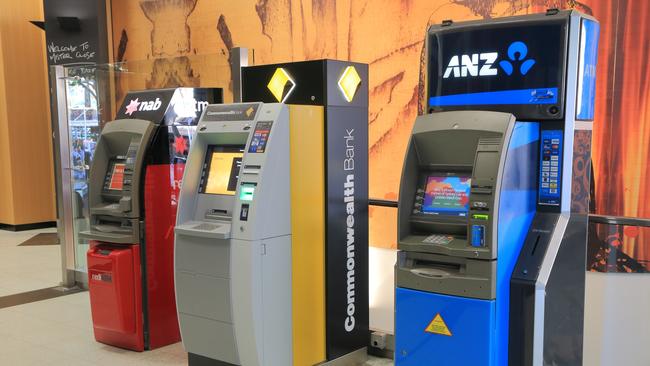Banks face tough debt road after Credit Suisse’s demise as investors re-evaluate risks
The write-off of Credit Suisse contingent convertible bonds will have far-reaching consequences, worsening the outlook for Australian banks’ profitability.

Australian banks may find it harder to issue hybrid debt after the events in Switzerland this week.
Experts warn that the decision by Swiss regulators to fully writedown the value of Credit Suisse contingent convertible bonds (CoCo’s) that was prompted by the forced merger of Credit Swiss with UBS, will have far-reaching consequences, worsening the outlook for Australian banks’ profitability.
S&P Global Ratings said Monday’s announcement by the Swiss Financial Market Supervisory Authority highlighted the fact that investors in this kind of debt – also used by Australian banks – showed investors “risk taking heavy losses as part of any bail-in, whether as part of a formal resolution or a market-based solution to help an ailing bank and protect its senior creditors.”
CoCo’s or enhanced capital notes, or Additional Tier 1 debt, are commonly known as “bail-in bonds.”
“Although many market participants had not anticipated that the Swiss authorities would enforce a 100 per cent writedown of the AT1 instruments without also wiping out common equity shareholders, the AT1 documentation, combined with the authorities’ legislative powers, made this outcome possible,” S&P analysts said in a report.
CoCo’s typically convert to equity securities if a pre-specified “trigger activation” event occurs.
S&P said the same outcomes for AT1 instruments in other countries may not automatically follow the Swiss pattern in the event of another bank collapsing. EU and UK regulators said this week that common equity is junior to AT1 instruments in the creditor hierarchy in their jurisdictions.
But according to the ratings agency, an increased focus on downside risk could increase banks’ cost of capital and make new AT1 issuance “more difficult and more expensive.”
“Jittery investors will take some time to revise their perceptions of risk for individual banks and instrument structures,” S&P added.
Macquarie Equities warned that each of Australia’s big four banks need to issue between $1bn and $2.5bn of qualifying Additional Tier 1 debt in New Zealand by January 2028.
“If that market is inaccessible, banks may need capital injections to meet their NZ targets,” said Macquarie analyst Victor German. “While credit markets could improve materially by 2026-27, we see increased uncertainty in banks’ ability to raise enough qualifying AT1s.”
He said that Australian banks are relying on their ability to issue AT1 instruments in NZ – which at this point remains largely untested – to meet higher NZ capital requirement. If this is unattainable, banks will face capital shortfalls with ANZ the most affected, followed by National Australia Bank, Westpac and Commonwealth Bank.
“This potentially opens a shortfall in their required NZ capital structure, which may need to be funded using CET1,” Mr German said.
Assuming banks only use equity to meet their higher NZ capital requirements, he sees a capital shortfall of about $5.5bn for ANZ, $4.2bn for NAB, $3.4bn for WBC and $1.1bn for CBA.
“While banks should make inroads to closing the CET1 gap organically by FY27, we believe capital injections may be required if NZ AT1 market is not accessible,” Mr German added.
AT1 debt spreads have widened following recent market instability, as debt investors re-evaluate potential risks associated with these securities. Despite some structural differences between markets, he expects the cost of AT1 and Tier 2 to rise, leading to further margin erosion.
However, while bank problems offshore have stemmed from deposit outflow issues, with regulators stepping in to protect depositors and given the strong financial positions of Australian banks, Mr German said the likelihood of material deposit outflows for the big Australian banks is “very low”.
Mr German estimates that 40-50 per cent of the major banks’ deposits are protected by the Financial Claims Scheme. Still, he expects more competition for stable deposits, given their increased importance in the funding mix, amid rising wholesale funding costs.
“We continue to see risk to bank margins and earnings in FY24 as consensus expectations do not appear to be fully reflecting higher wholesale funding costs and deposit competition,” he said.
Mr German’s 2024 margin forecasts for the major banks are 7-8bps below consensus, and his earnings forecasts are about 2-9 per cent below consensus.
“We see Australian banks as defensive but expensive in a global context and remain Underweight the sector,” he added.
Morgan Stanley analyst Richard Wiles said that balance sheet risks for the big four “remain modest”, but earnings risk has “increased”.
“We believe that the major Australian banks learned the lessons of the 2008 global financial crisis and have significantly strengthened their liquidity, funding and capital,” he said.
“In our view, balance sheet risk remains modest, but earnings risk has increased due to a likely move up in the cost of deposits and wholesale funding.”






To join the conversation, please log in. Don't have an account? Register
Join the conversation, you are commenting as Logout